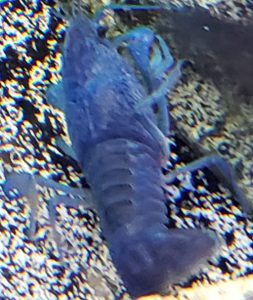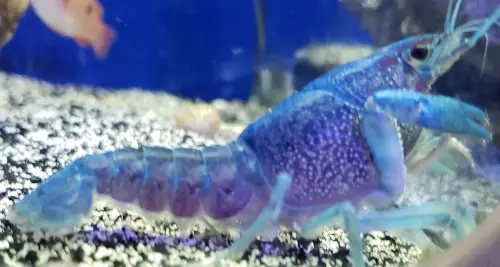
| Scientific Name | Procambarus clarkii |
| Difficulty | Easy |
| Minimum Tank Size | 20 Gallons |
| Diet | Omnivore |
| Aggression | Semi-Aggressive |
| Size | 2-6" |
Cobalt Blue Lobster Overview
The Cobalt Blue Lobster is a freshwater crayfish that originated in North America, off the coast of Florida. They are active tank dwellers that will explore and scavenge much of their time rather than hide under rocks. Crayfish are some of the hardiest livestock that freshwater has to offer. Other names for this invertebrate are the Electric Blue Crayfish, Sapphire Crayfish, or Florida Crayfish. This crayfish species has been selectively bred for the aquarium hobby for years to bring out its brilliant blue color. In the wild, you may find these crayfish in brown or tan colors as well as light blue.
When first introduced to the aquarium, the Cobalt Blue Lobster may appear tan or light blue from the shipping process. Once the lobster is acclimated to the tank it will gradually regain its vigor and blue color. As the Cobalt Blue Lobster grows from youth to mature, its color will deepen from a lighter blue to a darker blue shade. With proper care, these inverts can live up to 5 or 6 years. As Blue Cobalt Lobsters age they molt their exoskeleton. Molting happens frequently while they are young and growing and less frequently as they age. Crayfish species are vulnerable while molting, so it is important to have vegetation, rocks and caves for them to hide so they are not stressed when undergoing their molting. Sometimes you will see a Blue Cobalt Lobster eat their molted exoskeleton, and that is normal to retain nutrients and nothing to worry about.
Cobalt Blue Lobsters Habitat
Cobalt Blue Lobsters like to hide when they are feeling stressed, making it a good idea to have plenty of vegetation and rocks in the aquarium. The Cobalt Blue Lobsters also like to burrow, so sand is a preferable substrate if possible to use. Gravel will work fine for them to burrow as long as the gravel bed is deep enough and has enough space. These blue crayfish are escape artists so make sure your tank has a secured lid. Cobalt Blue Lobsters prefer a temperature between 65 and 70 degrees Fahrenheit, but they are hardy and the temperature can vary to other freshwater fish needs without trouble. A healthy pH for these crayfish is around a 6.5 or neutral 7. The Cobalt Blue Lobster does prefer a slightly hard water reading of about 3-10 dKH.
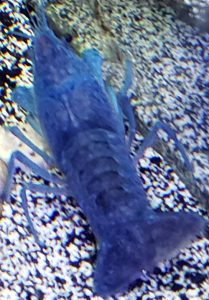
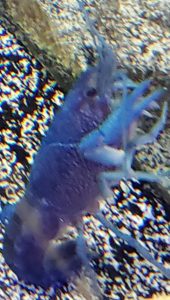
Feeding the Cobalt Blue Lobster
Cobalt Blue Lobsters are omnivores and will consume most meaty or plant-based foods that they can catch. They will scavenge most of the day in search of any food they can find on the substrate floor. A healthy diet for these crayfish will be packed with meaty foods they can scavenge from the substrate such as frozen mysis or brine shrimp, along with algae grazing from the tank. This diet should be supplemented with occasional sinking pellets, fish flakes, spirulina, algae wafers and optional blanched vegetables like zucchini, carrots, and spinach.
Do not overfeed your tank in worry of giving your Cobalt Blue Lobster enough food, since that will create toxic ammonia in the tank water. Two large fish flakes per day is plenty of food for a young crayfish, while two pellets a day is plenty for an adult crayfish. Keep in mind they can have less than this when adding pieces of shrimp or algae. With supplements, an adult crayfish may eat one pellet plus a couple pieces of shrimp and algae as well as tank grazing.
Take care not to give your Cobalt Blue Lobster food products with added copper, since too much copper is dangerous to their health. They will get their necessary copper from the trace elements in water, and will stay healthy with regular water changes.
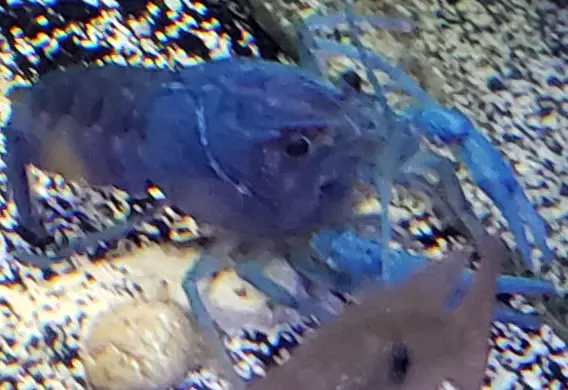
Cobalt Blue Lobster Tankmates
Cobalt Blue Lobsters are territorial towards other crayfish about the same size. They may be aggressive towards other invertebrates and fish that are slow enough for them to catch. Generally, larger but not too slow fish or fast fish will have no issues being kept with the blue crayfish. In efforts to prevent your Cobalt Blue Lobster from feeding on livestock, the aquarium the invert is kept in should be at least 20 gallons to allow territorial space. There should be plenty of hiding places such as vegetation, rocks and caves for fish to hide around and make their own territories. If two Blue Cobalt Lobsters are desired, they should be kept with caution and get at least 20 gallons each so that they can stay apart from each other. If the aquarium has a small, slow fish or another invertebrate like a snail or a shrimp you are worried about, you may want to reconsider getting the Cobalt Blue Lobster as the other specimen’s safety is never guaranteed.
Breeding Cobalt Blue Lobsters
Cobalt Blue Lobsters are generally easy to breed. A female Cobalt Blue Lobster will have shorter, more rounded claws. A male Cobalt Blue Lobster will have larger and more elongated claws, as well as having two claspers near his vent if you look at him upside down. While the two crayfishes perform their mating ritual, you will observe them cleaning each other. Afterwards, the female crayfish will carry the eggs in her pleopods, and they will hatch in about one month.
The eggs will hatch as miniature blue lobsters without organs, and in the initial 24 hours they will have their first molt. Many of the crayfish fry will not survive the molt. What you can do to help their survival chances is change the water frequently to provide clean water conditions, as well as immediately feed the fry brine shrimp or liquid foods. Take care of the crayfish fry by changing the water and feeding them regularly for about 2 weeks, and then they will be hardier and able to take care of themselves. The young Cobalt Blue Lobsters will be a clearer, transparent color until they have matured towards adulthood.
